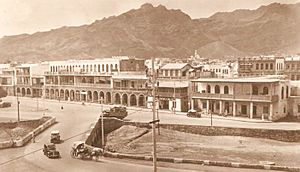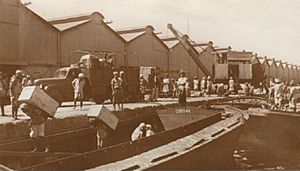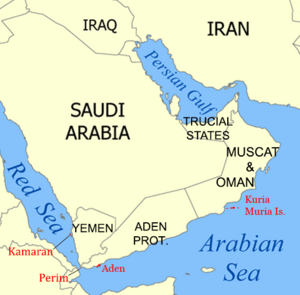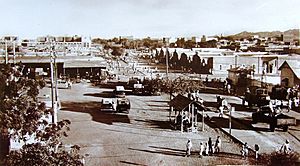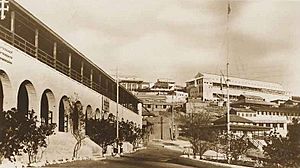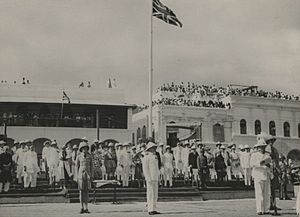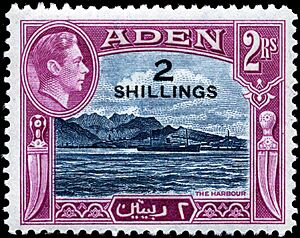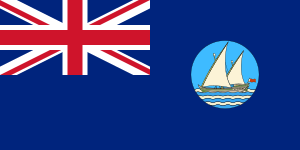Aden Colony facts for kids
Quick facts for kids
Aden Colony
مستعمرة عدن
|
|||||||||
|---|---|---|---|---|---|---|---|---|---|
| 1937–1963 | |||||||||
|
|
|||||||||
|
Anthem:
|
|||||||||
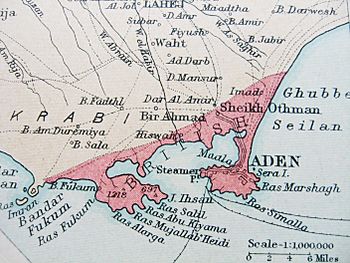
Map of Aden Colony
|
|||||||||
| Status | Crown colony | ||||||||
| Capital | Aden 12°48′N 45°02′E / 12.800°N 45.033°E |
||||||||
| Common languages | |||||||||
| Demonym(s) | Adenese | ||||||||
| History | |||||||||
|
• Aden Settlement established
|
1839 | ||||||||
|
• Aden Colony established
|
1937 | ||||||||
|
• State of Aden established
|
18 January 1963 | ||||||||
|
• State of Aden disestablished
|
30 November 1967 | ||||||||
| Population | |||||||||
|
• 1955
|
138,230 | ||||||||
| Currency |
|
||||||||
|
|||||||||
Aden Colony (Arabic: مستعمرة عدن) was a British Crown colony that existed from 1937 to 1963. It was located in the southern part of what is now Yemen. The colony included the important port city of Aden and the areas right around it, covering about 192 square kilometers.
Before 1937, Aden was managed as part of British India. It was first known as the Aden Settlement and later as a Chief Commissioner's province. In 1937, Aden became a separate British colony. This change happened on April 1, 1937.
On January 18, 1963, Aden Colony became the State of Aden and joined the new Federation of South Arabia. British rule officially ended on November 30, 1967, when the federation became the People's Republic of South Yemen. The areas around Aden Colony were governed separately as the Aden Protectorate.
Contents
History of Aden Colony
On January 18, 1839, the British East India Company sent Royal Marines to Aden. Their main goals were to create a supply port and stop Arab pirates from attacking British ships sailing to India. The British government soon realized that Aden was very important because of its location. The Royal Navy could easily use the port for supplies and repairs. Over time, British influence grew into the surrounding areas, leading to the creation of the Aden Protectorate.
Aden quickly became a vital stop for ships and a place to refuel for trade between British India, the Far East, and Europe. Its importance grew even more when the Suez Canal opened in 1869. From then until the 1960s, the Port of Aden was one of the busiest ports in the world for ship refueling, duty-free shopping, and trade.
In 1937, Aden officially became a Crown colony, separate from British India. This status lasted until 1963. The colony included the city of Aden and its nearby areas. The Aden Settlement, and later Aden Colony, also included the islands of Kamaran, Perim, and Kuria Muria.
Towards the end of its time as a colony, Aden faced many problems with civil unrest.
Queen Elizabeth II's Visit
On April 27, 1954, Queen Elizabeth II and her husband Prince Philip, Duke of Edinburgh visited Aden. This was part of their first trip around the Commonwealth. They were welcomed by the Governor of Aden, Tom Hickinbotham. They watched a military parade that included the RAF, Aden Protectorate Levies, and other forces.
During this visit, Aden held its first and only knighthood ceremony. A local leader, Sayyid Abubakr bin Shaikh Al-Kaff, was knighted. The Queen also knighted Claude Pelly, who was in charge of the Royal Air Force in the Middle East.
A bronze plaque marks the foundation stone that Queen Elizabeth II laid for Al Jumhuriyah hospital. The hospital was originally named after her. It was bombed in 2015 but is still open today thanks to a restoration project.
How Aden Colony Was Governed
The main law for Aden Colony was the Order of Council from September 28, 1936. This law was similar to those used for other British colonies. Aden city was seen as being very closely connected to the British Empire and developed faster than the surrounding areas.
One interesting fact about Aden was that sharia law was not used there. All legal cases, even those about personal matters for Muslims, were handled in the regular courts of the colony.
Within Aden Colony, there were three local government groups. The Aden municipality covered the main town areas like Tawali, Ma'alla, and Crater. The Township authority managed Sheikh Othman. And Little Aden, with its oil refinery and workers' homes, had its own separate body. All these groups were controlled by the Executive Council, which was overseen by the Governor.
Until December 1, 1955, the Executive Council had no elected members. After that, only four members were elected. The legal system was completely controlled by the British. Compared to other British colonies, Aden was slow to move towards self-government and more local involvement.
Education was available for all children, both boys and girls, up to an intermediate level. Students could get scholarships to study abroad for higher education. Primary and intermediate schools taught in Arabic. Secondary and independent schools used Arabic, English, Urdu, Hebrew, and Gujarati. There were also Quranic schools, but these were not officially recognized.
Economy and Money
After 1937, Aden's economy mostly depended on its role as a trading hub between East and West. In 1955, 5,239 ships visited Aden, making its harbor the second busiest in the world after New York. However, tourism decreased in the colony's later years.
By the end of British rule in 1967, the main sources of income for the Colony were the Port Trust and the British Petroleum oil refinery. The refinery paid a lot of money directly to the Aden Government.
In 1956, Aden Colony had a revenue of £2.9 million. This was one of the highest per person incomes among Britain's smaller colonies. However, Britain also spent a lot of money supporting the Aden protectorates, which had much lower incomes.
By the time British rule ended, the Federation of South Arabia, which included Aden, was receiving a lot of money from the British government to help with its budget.
Money Used in Aden
Since Aden was part of British India, the British Indian rupee was its currency until India became independent in 1947. In 1951, the rupee was replaced by the East African shilling, which was worth the same as the British shilling. Later, in 1965, when the South Arabian Federation was formed, a new South Arabian dinar was introduced. This dinar was also worth the same as the British pound sterling.
Aden became independent as South Yemen on November 30, 1967. It did not join the Commonwealth of Nations. The South Arabian dinar remained linked to the British pound until 1972.
People of Aden
In 1946, the colony's population was 80,516. By its second census in 1955, the total had grown to 138,230 people.
| Arabs | Somalis | Jews | Indians | Europeans | Miscellaneous | Total |
|---|---|---|---|---|---|---|
| 103,879 | 10,611 | 831 | 15,817 | 4,484 | 2,608 | 138,230 |
The 1955 census showed that the Arab population included Aden Arabs, Protectorate Arabs, and Yemeni Arabs. The European population included British people and other Europeans. The Somali population in Aden was there even before the British arrived. The Jewish population had been over 7,000 in 1946, but it decreased after many Jews moved to the new state of Israel in Operation Magic Carpet.
The colony's population grew to over 200,000 people in the 1960s.
Challenges in Aden
Worker Movements and Protests
Trade unions became a way for people in Aden to show their unhappiness. The first union was formed in 1952. By 1956, most types of workers had formed a union. People expected that Aden's unions would develop like those in Britain. However, in Aden, it was hard to separate nationalist feelings from economic complaints. Because of this, strikes and protests were often for political reasons, not just about pay or working conditions.
The British Army returned to Aden in July 1955 after rebel tribesmen, armed by Yemen, caused problems. Minor incidents continued into early 1956.
In March 1956, workers at the Little Aden oil refinery went on strike for ten days. They mostly wanted better pay. During the strikes in 1956, there were many attacks on non-Arab groups. The Army took over command of Aden from the Royal Air Force to keep things safe.
In May 1958, a state of emergency was declared. There were several bombings until the main people causing trouble were arrested in July. However, in October 1958, there was a general strike with widespread riots. This led to 240 Yemenis being sent away from Aden. Some people believed that ignoring the local workers' feelings pushed many Arabs to oppose British rule.
Many blamed these problems on broadcasts from Radio Cairo, which was encouraged by Nasser's anti-imperialist and Arab Nationalist government. These broadcasts helped spread a feeling of Arab Nationalism among people who had felt isolated.
In December 1963, there was a grenade attack on the high commissioner, who was not hurt. However, three bystanders were killed.
Jews in Aden
Jewish communities had lived in Aden and Yemen for thousands of years. They were mainly skilled workers and craftspeople. After the British took over in 1839, Aden became an important center for Jews.
During the two World Wars, Jews in Aden did well, while those in Yemen suffered. The Balfour Declaration encouraged more Jewish people to move to the Holy Land. As a result, many Jewish communities from across the Middle East looked for a new home there. The issue of Palestine greatly affected how the British were seen in Aden.
During Second World War, many Jews from Yemen came to Aden on their way to Palestine. They were placed in refugee camps for their safety. However, conditions in the camps were difficult, and in 1942, there was a Typhus outbreak. The need for these camps became clear in December 1947. After the UN decided to create a Jewish state, serious riots broke out in Aden Town. At least 70 Jews were killed, and much of the Jewish Quarter was burned and looted. Until this point, most refugees had been from Yemen and the Aden Protectorate. But after the violence in Aden Town, most Jews tried to leave. The Jewish population dropped from about 4,500 in 1947 to less than 500 by 1963.
The 1948 Arab–Israeli War made it very hard to move to Israel, as the Red Sea and Suez Canal were closed by Egypt. By 1949, after a ceasefire, 12,000 Jews from Yemen, Aden, and the Protectorate were gathered in camps. From there, they were flown to Israel in Operation Magic Carpet.
Aden's Importance to Britain
Aden was in a very important location for shipping, on the main routes between the Red Sea and the Indian Ocean. During the British Empire, the port was key for communication and refueling ships between the Suez Canal and India. Even after India became independent, Aden was still seen as a vital part of Britain's global defense. By 1958, Aden was the second-busiest harbor in the world, after New York City. It was very important for protecting British oil interests in the region.
The Little Aden oil refinery was essential to Aden's economy. It could process 5 million tons of crude oil each year and was one of the colony's only exports. Keeping this refinery safe was a top priority for the Aden government.
For much of Aden's later history, its relationship with the United Arab Republic (UAR) was very important. The UAR was formed in 1958, and this made Aden even more important as a British military base. However, even before the UAR, Arab nationalism was growing among people in Aden.
The most serious problem for Aden in the late 1950s and 1960s was its relationship with Yemen and Yemeni raids along the borders. When Yemen joined the UAR, it created a difficult situation and many political problems. Immigration into the Colony was a big concern for the local Arab workers.
Some writers believed that the British presence in Aden actually caused more anti-British feelings among Arab nationalists, rather than helping peace efforts.
Joining the Federation and End of Colony
To solve many problems and continue the process of self-rule, it was suggested that Aden Colony should join a federation with the protectorates of East and West Aden. It was hoped that this would reduce Arab demands for full independence, while still allowing Britain to control foreign affairs and the BP oil refinery at Little Aden. The British government hoped that creating a federation ruled by traditional sultans would allow them to keep indirect control. However, the people of Aden were mostly city dwellers, educated, and often had modern political views. The people in the protectorates were mostly rural, less educated, and more traditional. This made the proposed federation a difficult match.
Ministers from both the colony and protectorates first suggested the federation. They argued it would be good for the economy, and for people of similar backgrounds and languages. However, this step was not logical for Arab Nationalism. It happened just before some elections and went against the wishes of many Aden Arabs, especially the trade unions. Another problem was the big difference in political development. Aden Colony was already moving towards self-government, and some people felt that joining with the autocratic (ruling with absolute power) and less developed Sultanates was a step backward. In the federation, Aden Colony was to have 24 seats on the new council, while each of the eleven sultanates would have six. The federation would receive financial and military help from Britain. Most people in Aden opposed the federation, leading to strikes and protests. The elections for the council were also rigged to favor supporters of the federation. From the very beginning, the federation was seen as not legitimate.
On January 18, 1963, the colony was renamed the State of Aden (Arabic: ولاية عدن) and became part of the new Federation of South Arabia. Sir Charles Johnston stepped down as the last Governor of Aden.
Many of the problems Aden faced as a colony did not get better after it joined the federation. Internal unrest continued and grew worse, leading to the Aden Emergency and the final departure of British troops. British rule ended on November 30, 1967.
The federation then became the People's Republic of South Yemen. Like other former British Arab territories in the Middle East, it did not join the Commonwealth of Nations.
Governors of Aden Colony
- Sir Bernard Rawdon Reilly (1937–1940)
- John Hathorn Hall (1940–1945)
- Reginald Stuart Champion (1945–1950)
- Sir Tom Hickinbotham (1951–1956)
- Sir William Luce (1956–1960)
- Sir Charles Johnston (1960–1963)
See also
 In Spanish: Colonia de Adén para niños
In Spanish: Colonia de Adén para niños
- British foreign policy in Aden
- Jews of Aden
- Yemen




